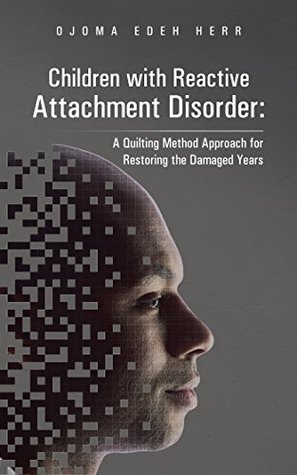Download Children with Reactive Attachment Disorder:: A Quilting Method Approach for Restoring the Damaged Years - Ojoma Edeh Herr file in ePub
Related searches:
Interventions for children with reactive attachment disorder
Children with Reactive Attachment Disorder:: A Quilting Method Approach for Restoring the Damaged Years
When people don't get it: Raising children with reactive attachment
Working with Children Who Have Reactive Attachment Disorder
Parenting a Child with Reactive Attachment Disorder
10 Ways To Discipline a Child with Reactive Attachment Disorder
How to Discipline a Child with Reactive Attachment Disorder - Every
Reactive Attachment Disorder in the General Population: A Hidden
Recognizing the Signs of Reactive Attachment Disorder
Aggression in Children With Reactive Attachment Disorder: A Sign
Behavioral and Personality Characteristics of Children With
When people don’t get it: Raising children with reactive
Are All Kids with Reactive Attachment Disorder Violent?
Reactive attachment disorder goes far beyond typical childhood irresponsibility and tantrums. As these kids grow older, they may display rage, screaming, swearing, damage of your possessions, manipulation and, occasionally, violence. Many parents wonder if their child is intentionally setting out to destroy the family.
Reactive attachment disorder (rad) is a condition found in children who may have had grossly negligent care and don’t form healthy emotional attachments with their primary caregivers -- usually.
Children with reactive attachment disorder missed the developmental milestone opportunities for their brains to keep up with their physical ages. Therefore, they lack the maturity to think beyond themselves. Just like two-year-old children, they focus on the moment, their needs, and what they can get from others.
The authors compared behavioral and personality characteristics of children with reactive attachment disorder (rad) with non-rad children.
In reactive attachment disorder, infants, children, and teens can’t bond with others. The child with rad is withdrawn from the world because he/she can’t trust people, even people who are currently trying to love them. Love is, in fact, one of the biggest challenges and frustrations in parenting a child with reactive attachment disorder.
Reactive attachment disorder (“rad”) is a common disability for children who were abused or neglected when they were very young. It is essential that lawyers who work with children understand this disability.
Reactive attachment disorder (rad) is a serious condition in which infants or young children do not establish healthy attachments with a primary.
Common signs and symptoms in young children include: an aversion to touch and physical affection.
This may help you in recognizing the signs of reactive attachment disorder, commonly known as rad in your child.
Attachment disorders come in degrees of severity, with the most severe being reactive attachment disorder.
A child with reactive attachment disorder (rad) has been subject to neglect or abuse and fails to establish the expected bond with his primary caregivers,.
Reactive attachment disorder (rad) is a rare but serious condition in which an infant or young child does not form healthy and secure bonds with their primary caregivers. Children with this condition struggle to form relationships with others, rarely seek comfort from caregivers, and have trouble managing their emotions.
Reactive attachment disorder (rad) is a trauma disorder that occurs in infancy or very young childhood; however, the effects of reactive attachment disorder are long-lasting and can be seen in children and teens (reactive attachment disorder in adults).
Most often, attachment disorder means that children cannot develop important relationships and social skills later in life. This disorder can be recognized by a large number of symptoms, like anger and emotional issues, moodiness, a tendency to seem untrusting or disconnected.
Reactive attachment disorder is most common among children between 9 months and 5 years who have experienced physical or emotional neglect or abuse. While not as common, older children can also have rad since rad sometimes can be misdiagnosed as other behavioral or emotional difficulties.
The aacap guidelines state that children with reactive attachment disorder are presumed to have grossly disturbed internal models for relating to others. However, the course of rad is not well studied and there have been few efforts to examine symptom patterns over time.
“overall, studies tend to find that between a third and a half of children are insecurely attached. In very high-risk populations – where families face multiple problems – up to two-thirds of children are insecurely attached.
Attachment is the main component of social and emotional development during early childhood. Children with rad almost seem fearful of their parents/caregivers and rarely show signs of comfort. Rad is most common among children between 9 months and 5 years.
Reactive attachment disorder is a rare but serious condition in which an infant or young child doesn't establish healthy attachments with parents or caregivers. Reactive attachment disorder may develop if the child's basic needs for comfort, affection and nurturing aren't met and loving, caring, stable attachments with others are not established.
Feb 1, 2013 reactive attachment disorder (“rad”) is a common disability for children who were abused or neglected when they were very young.
Children with reactive attachment disorder experience their parents' frustration and anger as proof that the youngster is effectively controlling.
Reactive attachment disorder (rad) children with rad are less likely to interact with other people because of negative experiences with adults in their early years. They have difficulty calming down when stressed and do not look for comfort from their caregivers when they are upset.
Reactive attachment disorder and the related disinhibited social engagement disorder are rare but serious disorders that can afflict children who have failed to form normal, developmentally.
Reactive attachment disorder is a rare but serious condition in which an infant or young child doesn't establish healthy attachments.
Children with reactive attachment disorder are believed to have the capacity to form attachments, but this ability has been hindered by their experiences. And even those who've been neglected, lived in a children's home or other institution, or had multiple caregivers can develop healthy relationships.

Post Your Comments: